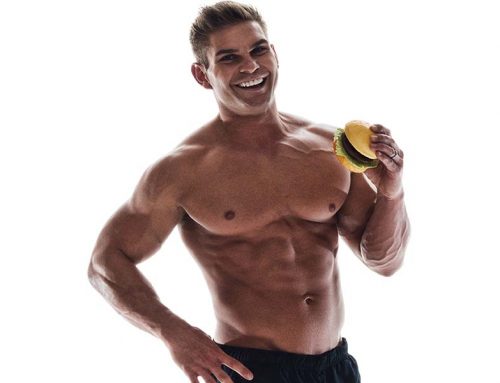Are you an ectomorph, mesomorph or endomorph body type? To maximize your results, regardless of whether your goal is fat loss or muscle gain, it’s helpful to know your body type and adjust your approach according to your type. But a big question that almost no one has ever answered is, “Does your body type change over time?” If so, then what? Do you have to totally change your nutrition and training again? And if your body type doesn’t change, does this mean you are stuck being a fat endomorph for the rest of your life, doomed because of genetics? Read today’s blog post to find out..
Somatotype is a 3-part, 7-point body type rating scale developed by a guy named Sheldon back around 1940 or so. Ectomorphs are the linear, bony, lean types, mesomorphs are the naturally muscular body types (yeah, the ones we hate!), and endormorphs are the ones with the round body shapes and the genetic tendency toward storing more body fat.
Generally, you have a combination body type, which is why you are scored with 3 numbers (Arnold Schwarzenneger in his bodybuilding prime: think pure mesomorph with the highest score of 7).
The question is, Does somatotype change? this is a very interesting question that has been asked and debated before both by the layperson (often bodybuilding and fitness enthusiasts) and by scientists.
Two of those scientists were JE Lindsay Carter, a physical education professor from San Diego State University and Barbara Heath, and Anthropologist from the University of Pennsylvania.
There was initially a lot of debate and antagonism provoked by the classic Sheldon system of classifying human body types (“somatotyping”), because initially, Sheldon was very rigid in his insistence that body types were permanent and did not change.
However, Heath and Carter proposed that it was plain to see that body types DID change due to normal growth, aging, physical training and dietary deprivation (they cited the Minnesota starvation study, where subjects started out looking somewhat mesomorphic and ended up looking like ectomorphic POW camp victims, literally).
Heath and Carter weren’t trying to dismiss somatotpying, they supported it and wanted to validate it.
However, they wanted to address the shortcomings of the somatotyping method and one of those was the fact that the Sheldon system didn’t accommodate for changes in physique as a result of training and nutrition.
In their voluminous 1990 textbook on the subject, Heath and Carter define somatotype as:
“A quantitative description of the present shape and composition of the human body. It is expressed in a 3 number rating, representing three components of physique: (1) endomorphy, (2) mesomorphy and (3) ectomorphy. The somatotype can be used to record changes in physique and to estimate gross biological differences and similarities among human beings. This method of somatotyping is sensitive to changes in physique over time and is used for rating both sexes at all ages.”
Look at a guy like John Bartlett for example, one of our inner circle contributing authors and an outstanding natural competitive bodybuilder. When you see him today and you ask what is his body type, you would say, “MESOMORPH all the way!”
That’s because today he is ripped and muscular
But if you look at his before picture and ask “what is this guy’s body type” you would say, “Endomorph” all the way or at least “endo-mesomorph” because he did have a solid and stocky build before, but also a high body fat percentage.
Well, which is it? Or did his body type change? Clearly, John gained a lot of muscle and lost a lot of fat and looks totally different today. So could we say his body type changed? If we go by current outward appearance, then yes, absolutely.
But does this mean his body type really changed or did he overcome an inherent endomorph body type to achieve where he is now?
Or, to play devil’s advocate here, was he always a mesomorph inherently and he just really let himself go for a while and he was just returning to his normal body type of mesomorph?
These are interesting questions. The Heath-Carter method simply includes body composition as part of the rating scale of a person’s body type and says that you can rate someone based on how they look now. That includes bone structure (which changes little or not at all after adulthood) AND body composition (which can change throughout life). So you could say John was an Endomorph and is now a Mesomorph. Predominantly Mesomorph is his present classification.
However, at the same time, we could say that a person DOES have an inherent body type or set point – a physique that they will gravitate towards in the absence of circumstances or concerted efforts to change it.
I addressed this issue of changing body types versus an inherent (or “permanent” body type) in Burn The Fat, Feed The Muscle (BFFM). The way I explained it is that I said your true body type is what you will gravitate to naturally when you are not in a highly trained state. It’s your inherent tendency. In that respect, you could say somatotype does not change, while body composition does.
In chapter 5 of BFFM I said there were three additional ways to know your inherent body type beyond Sheldon’s scale, which take into account changes in physique due to training and nutrition:
- How you looked before you took up training (your “natural” body shape)
- How you respond to training and nutrition (ease of muscle gain or fat loss)
- How you respond to de-training (how well you retain lean mass and low body fat or how quickly you lose lean mass and gain fat on cessation of training)
If you wanted to make this even MORE complex, we could look at somatotyping by considering not just the outward bone structure and body composition of an individual, but also the metabolic (interior) characteristics
My “Burn The Fat” system of body typing is like a combination of:
(1) Metabolic typing (internal metabolic characteristics like carb tolerance)
(2) Somatotyping (external body shape – linearity or roundness, fatness or leanness)
(3) Miscellaneous other genetic factors.
That would be a pretty good three-part body typing system that covers the concerns about changing body types, individual metabolic types (“carb intolerant types” or protein types, etc), and genetics (which is especially relevant since obesity genes have been identified fairly recently).
I hear criticisms of the somatotyping system all the time, where people say it is not useful. I disagree. Yes, it’s perhaps too crude of a system to base your entire training and nutrition plan upon, but I believe it’s very helpful as a general tool to “KNOW THYSELF”.
In other words, if you are inherently an endomorph and you KNOW IT, then you know darn well what happens when you don’t do any cardio. You know what happens when you cheat four or five times in a week. You know what happens when you slack off. You gravitate towards gaining fat, because that is your body type’s tendency! So you can adjust your training, nutrition and lifestyle accordingly.
If you are an ectomorph, then you know what happens when you skip meals… you don’t gain any muscle! You know what happens when you do too much cardio… you don’t gain any muscle, or you lose some!, etc. etc.
And if you’re a mesomorph…. did I mention…. we hate you!
If you’d like to learn more, chapter 5 in Burn The Fat, Feed The Muscle is about body typing. It’s full of some really valuable and motivating lessons about knowing yourself, your body and your genetics and understanding the importance of taking personal responsibility, regardless of your hereditary predispositions. If you already have the book, it’s worth re-reading periodically.
Tom Venuto
Author, Burn the Fat, Feed The Muscle
Founder & CEO,Burn The Fat Inner Circle
PS. Just kidding mesomorphs… we don’t really hate you, we just envy you!
PPS. You can leave your comments below, or, if you are a burn the fat inner circle member, CLICK HERE To discuss somatotyping in the inner circle forums!
Related articles
Endomorph Body Type Secrets: Are You Eating Wrong For Your Body Type?
References
Somatotyping: Development and Applications, Carter JE, Heath, Barbara, Cambridge University Press, 1990.
Sheldon, William, The Varieties of Human Physique, Harper & Brothers, 1940
No reproduction of this article is permitted








I remember that chapter very well in your book and after that chapter I knew that I could never approach my lifestyle the same again.I am an endomorph through and through, I eat way too much when I don’t plan and gain lots of fat very quickly!No I know why I gain fat quickly and have to face that fact.Always great to read your blog posts Tom.RegardsNico
Interesting comments about body types. As an endomorph I presume I am condemmed to 3 days a week training and reasonable diet cotrol for the rest of my life. At the moment its not a problem as I work away from home for 6 weeks at a time so I can train 3 to 4 days a week. When I return to London I will have to leave the house ay 6 in the morning and return at 7 in the evening. Such a working day is not condusive to training.What can be done during a two day weekend to stay in shape
Yet another thought provoking post Tom!I recall an amazing audio that you have posted in the Burn The Fat Inner Circle where Marc David grilled the heck out of you and this very topic came up.I remember your shock when he mentioned that he was an ectomorph because currently he has a significant amount of muscle. I believe the important issue that came up was how people will use the label of their somatotype as an excuse… For example, “I’m an endomorph and I’ll never be ripped.” or “I’m an ectomorph and I’ll always be a hard gainer.”No matter what our somatotype, if our goal is to always become the best that we can be it’s amazing what we can accomplish.Thanks for being an incredible leader in the fitness industry Tom and for sharing your passion with all of us. You ROCK!Scott Tousignant
george, “condemned” to eat right and exercise?. What an awful way to look at it. Thats sure to get you fired up to work out eh? Seriously, the answer is yes – “eternal vigilance is the price of freedom” as Jefferson said, and eternal vigilance is also the price of leanness for the formerly overweight.Yes an endomorph will need an active lifestyle, as in forever, but why not change the words you use to describe it, and find some activity you can enjoy. Did you know that john bartlett NEVER did cardio in a gym??? He lost all that fat mountain biking inthe beautiful hills of arizona and built the muscle with bodybuilding, which he also loved to do.I love my training and wouldnt give it up for the world. Everyone can find some kind of activity they love.And when youre busy, get creative and get dedicated. Our recent mens burn the fat challenge champion transformed his body in 50 days while working 12-14 hours a day. There is always a way and theres never an excuseCheers!
Great post Tom. So many people HAVE never heard of somatotypes and they are unaware that each type has its own needs and demands.I guess this is why people who should probably be lifting more are out running should be in lifting and people who are in lifting but need to shed fat should be reducing the time spent lifting and more time spent monitoring their eating habits. We gravitate towards things that we either A) like or B) find easy. Changing your type is certainly not easy!Thanks for bringing it to light.
I remember that chapter. It was a little frustrating and I still have a hard time classifying myself.I would like to see someone explore the difference between male and female somatotypying. I think it is something worth exploring because men and women’s bodies are so different, especially in the context of childbearing.
Very interesting! I think I am a very mixed type as I’ve never been able to quite figure out my type when I try the quizzes. Glad to see that concept mentioned.
I am an extreme endomorph too, I think I should have scored 7 on the (bloody) endomorph scale prior to meeting Coach Tom Venuto, the man responsible for changing my life so radically, that people I used to know from College hardly recognise me on the street anymore, heh.The way I see it, is that I was born to suck. Sorry for putting it so bluntly, but it is my way. Coach Venuto was the person who just explained to me that although my genetics failed epically, there actually WAS a way to change the way I looked permanently and also that NOBODY is doomed solely by genetics to fail at life or even to fail at failing. (Yeah I had taken failing at a brand new level prior to reading Tom`s BFFM).Now, three years after reading Tom`s BFFM my BF level is at 12ish% percent, and I am diligently working towards my first-evah six pack, which I am damn sure that I will achieve by June 01 this year. Guaranteed. My BF percentage used to be over 30% in the Before Tom Venuto era. I was never ever lean. Even when I was serving, I was a `skinny fat person`, not really lean.Someone said that they feel condemned to work out three times a week, haha, that`s nothing I work seven days per week, 30 days per month, 365 days a year. It has become an unconscious habit. The first thing I do upon waking up is drinking my protein shake and then immediately thereafter I hit the treadmill. I don`t even halt to think about it, I just do it. It`s as if I am a programmed robot or something. Frankly, I have no idea how it has come down to this, although I admit I have read Tom`s BFFM over 20 times so far, cover-to-cover, and I still read it from time to time. I have also read Tom`s favourite, Psycho-Cybernetics.The best part, is that I KNOW I have Tom`s respect. Tom said in BFFM that he is not impressed by a genetic superior (aka Mesomorph) who is just coasting on their genetics, but what really impresses him is the guy with the below-average genetics who keeps getting knocked down and yet stands up to fight again, and again and again until he makes it. I feel I have done just that, and Tom Venuto is responsible.I will describe how I used to be prior to reading BFFM: I was always tired. I even woke up in the morning and I felt tired. I never did anything that included stenuous activity. I didn`t even wash my car. All I did was sedentary stuff, like playing computer games, surfing the net and reading books. That`s it. Now, think that this kind of person became the kind of person that wakes up in the morning and runs 10 kilometers on the treadmill, without even breaking too much sweat, day after day. And imagine that Tom actually talked me into becoming a musclehead through his BFFM e-book. I didn`t even know what `dumbbell` and `barbell` meant :-)Cheers :-)
Nikos, great job. and thanks!
I was an ectomorphic mesomorphorph ’til I hit my 30’s then my body wanted to be a endomorphic mesomorph! I’ve always had good muscle mass but have had to adapt to how my body wants to store or gain fat as i’ve gotten older. Advice anyone?
Tom thanks for the interesting topic.I believe its a mistaken idea that you can ‘see’ body typing in an UNTRAINED person. For sure some of this is ‘visible’ – but the most important two I believe most people are concerned with are metabolic type i.e. how easy or hard it is to burn fat, and muscle fiber since its only faster twitch that produces those visible muscles – the amount of slow/fast twitch they have.It was widely believe that muscle fiber makeup is genetically inherited and largely unchangable, so much so Russian and China selected kids through testing for specific atheletic events.I’ve read and followed studies for last 20 years, now its clear training CAN alter fiber types( and there really is a spectrum of fibres frm slow to fast), but there is always a heavy genetic component. Also the research does NOT widely support the idea of converting slow to fast, so a person with 90% slow inherited ideal for distance, cannot likely ‘train’ to gain large % of fast and become a sprinter – or a bodybuilder etcI’ve been an athlete my whole life and around them, and i’ve tried many experiments on myself. I anecdotally would say its roughly 50% genetics, 50% training …which means any person can make dramatic changes, but you won’t fundamentally alter you body type – if your a small build ‘distance runner’ type, you won’t become a world class bodybuilder and vice versa- but you can ‘look good’ – by lowering body fat as per Tom’s methods and maximizing what faster twitch you do have. But if your a ‘hard gainer’ type training has to be specialized i.e. cut our aerobics, eat more etc whilst a person with higher % fast twitch this is less important. For me, as an ex-4.30 miler in my 20’s, I had to stop running to gain muscle, and train at low volumes and High intensity – for other people, it will be different.The biggest thing i’ve learned from 25 years doing weights and running is to be humble about the science and making claims, because not everyone fits the rules, most do but some people have individual genetic makeups, and really the hard task is to find ‘what training works for them’ – high or low volumes, how much aerobics, right amount calorie’s about/below metabolic needs etc. The science of studying exercise is so difficult, that studies can be found to support almost any claim, but here’s a few studies of interest on difficulty of ‘switching twitch’.http://www.the-aps.org/publications/classics/articles/ingalls.pdfFWIW from my own experiment! – I weighed 135lbs (5’9) age 25 typical distance runner, max bench 150lbs (run 4.30mile), I stopped running for 10 years !! just did High intensity weights and ate ABOVE maintenance, at age 40 I added 15lbs muscle to 155 (extra 5lbs fat!)…max bench 230lbs! ….I have started running & I’ve KEPT the muscle/strength, lost the fat – back to 5% body fat at 42, and can now run 5.30mile again…but my SPRINTs are FASTER at 42 than when I was 20 which, so specific training DID increase my faster twitch, but i’m still the same basic body type.
“Tom, I laughed so hard when you said.. “If your a mesomorph.. did I mention. we hate you” Ain’t that the truth.. I am an endo-meso and started training for my bodytype.. (high rep-high set-low rest) to burn alot of calories (and the fat) off of me.. Since I have been training that way I have gotten alot leaner. And actually my weight has gone up!”
Good post and good chapter Tom. As an endomorph, I know that it’s always going to be a lifetime balancing act between my training and nutrition.Also, I think that endos need to find creative ways to move more that’s not viewed as structured cardio. Taking the steps, parking father from the front door of the store, pacing while talking on the phone, etc. all are now part and parcel of my life as someone whose body loves to store fat …
Thanks, Tom, this post just definitely made my day! :) I really hate approaches which don’t include change in their concept, and believes that we are predetermined… they are right in many ways, but still, people do have control. I know what would happen if I went back to the life I used to live but I won’t… because people who used to know me now don’t recognize me on the street, and this feels too damn good!
I have no idea what type I am. It’s very hard for me to lose weight for one. I can exercise 1 hour a day, 5 days a week and the scale is the same. But, I gain a pound or two a week if I overdo my eating.I am no fat, but am not skinny. Sounds like a riddle.I used to eat 1300 calories a day and was comfortable with that.I have muscle under my fat.Basically, I’m thinner than the photo of the guy above.I come from a muscular family.And I was overweight as a child, turned into super-skinny and now weigh 239.Every diet I tried did not budge the scale except the one week I tried NutriSystem.What am I?I haven’t read the book yet, I just bought it.
Tom thank you very much for the wonderful information. I know from my own experience that my weight gain was slow but consistent through my late 30s and 40s. Reading your BFFM was a real eye-opener. You accurately described my path to being overweight and tired. A large part of the book was a series of ah ha’s! Your wealth of knowledge and deep insights gave me the confidence to know that your system is going to work and work very well. I was and still am amazed by the bargain. You literally give the keys to a better life for less than 40 bucks.I probably have to say I was more like Ian in the earlier examples regarding body types. But with less than a month into your program I am already returning quickly towards my former ectomorphic mesomorphorph state. I’m probably more towards the ectomorphic end. I just checked the chart and it shows I’m down almost 18 pounds of fat and have gained just shy of 10 pounds of muscle. Maybe I’m closer to a mesomorph!All l’ve been doing is throwing my bike on some rollers and peddling for half an hour to 45 minutes a day. Plus a little bit of upper body work with calisthenics and light dumbbells maybe once a week. With the changes I see in my body, I am completely addicted to my simple exercise regimen. I can never remember eating so much. But I can remember the feeling of energy I have now. It’s like you’ve turned my clock back 30 years.The system works. It’s awesome. Thank you for helping us change our lives.
When I had surgery on my very broken toe I was unable to put any weight/pressure on my left foot for over a month and there after only for a limited time. I found that my left leg atrophied somewhat. I’m ecto-meso and found that my muscle was lost quicker than gaining weight. I am now able to gain my lost muscled so I’d say that in your BFFM you were right on with your writings.
this is helpful. got your e-book. i am at the point that any improvement is good with me(and no, i am not settling for less). I am a straight endomorph with some meso characteristics (i can build muscle easy and am strong) but ah, the fat, the fat. Yes, i have come to the conclusion that i may never be thin with a six-pak for a lady, but just to lose the flab after 8 pregnancies 25 years later and understanding how that you can actually be something else that what you look like is quite inspiring. I guess i needed this bec i just downed two slices of thin-crust pizza after putting together an elliptical only to see one of the arms loosening, ugh! I keep remembering what you said in BFFM; this body-type can be unforgiving with cheat days!Okay enough of the yammer-kutzing; i am pleased with this info and thanks for sending this out. You can’t judge a book by it’s cover, can you?
I am familiar with Dr. Sheldon’s book. I have studied it. I have found this article and the blogs quite informative. It appears that there is a systematic age driven shift in somatotype that is above and beyond the outward shifts due to diet and training. The inheret somatotype does shift somewhat with age. I started out as an ectomorph and through training moved towards the mesomorphic pole to become an ectomorphic mesomorph; however advancing age (now about 80) is drifting me towards the endomorphic pole. Living in the west Pacific area probably explains some of it. Much of my exercise is done by running in place and jumping an imaginary jump rope. I have to work harder to flatten the belly. And at my age belly flattening is very important. Blood pressure control is largely a matter of exercise. In my exercise I shoot for 100% VO2. When I am out I walk fast, flat foot style (bring foot down flat on the ground with knees always bent and over the foot). This prevents sports injuries. This style of walking if done fast enough can get you close to 100% VO2. Parashont
Go ahead people , look in the mirror and get to “KNOW THYSELF”…for I have heard it be said that the proper study of mankind “IS” man!…so study “thyself”!…get to know “YOU”.(:
very detailed as usual Tom!Personally, it’s interesting how I’ve noticed that I can gain fat very easily if I go for a week eating like a typical american (such as on a vacation). However, I can also lose body fat extremely easily too if I simply eat nutritionally sound and train hard. The hardest thing for me is gaining muscle mass, so I gear my training and diet for the most part towards gaining and/or maintaining mass. If I stop training for a couple weeks or let my diet slip, I lose muscle VERY easily and it takes 3 times as long to put the muscle back on as it took to lose it. The interesting thing is that if I train with the goal of muscle mass, it actually helps me to stay leaner, whereas if I train with the goal of fat loss, I end up losing muscle mass and making it easier to gain body fat. This would be the opposite of how a endomorph might train.Interesting topic Tom… keep em coming!
Never heard of Dr. Sheldon or his book – I’ve added this to my reading list.Totally agree that it really helps your approach for weight loss and muscle gain if you know your body type. Could save you loads of frustration as mentioned above.Mike
I am 49 years old and female. I build muscle very easily but retain a layer of fat over the top. Actually mostly it is water but it takes up space like fat, (in my lower body only) my top is very very lean. Like one of the postings above I need to do an hour at least of cardio to get lean, 5 times per week.high protein low carb diet works best but still i have a bit to lose. I lift quite heavy with my upper body to keep it balanced and only do cardio (fast running, cycle or crosstrainer) to lean out my lower body. Guess I would be meso/endo (sigh).
I’m an endo-mesomorph. Was 200 pounds now I’m 180. My whole family (the men) are naturally born mesomorphs. I guess you can say that I’m a mesomorph now.
This is a good research. Well, it’s hard to be an endomorph to stay in good shape. I’m endomorph with hypothyroidism, adrenal deficiency and knee cap problem, though many people say I’m in very good shape, with 15% bodyfat and weight 66kg (though I’m pretty short with 165cm height). But the diet and cardio training is killing me. I’m very worn out because of the training and stress. I’m in my 33’s. 30-60 min 4 days cardio and 60-90 min weight training 3 days a week. And still need to fight my appetite and concentrate to study. I’m still a worker that need to pursue my career in banking and a postgrad student in finance that need to study hard. I wonder if there any ways that can lessen the pain… Well, need my best appearance for career and social life… Thanks
Good to know I’m not the only one that hates mesomorphs haha. Btw good information in this article!